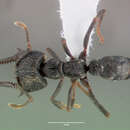en
names in breadcrumbs


Taxonomic history
Lectotype designation: Yoshimura & Fisher, 2014 PDF: 85.[Mystrium oberthueri Wasmann, 1897a PDF: 250. Nomen nudum (attributed to Forel).].Emery, 1899e PDF: 267 (m.); Yoshimura & Fisher, 2014 PDF: 85 (w.eq.m.).Status as species: Emery, 1899e PDF: 267; Emery, 1911e PDF: 23; Wheeler, 1922: 1006; Menozzi, 1929e PDF: 530 (redescription); Brown, 1960a: 170; Bolton, 1995b: 287; Yoshimura & Fisher, 2014 PDF: 85 (redescription).Il Sig. Mocquerys ha raccolto una [[ worker ]] di questa specie e un [[ male ]] che credo dovere riferire alla medesima. Differisce dal [[ male ]] di M. mysticum per i punti seguenti: la grandezza minore, il torace piu largo, le antenne molto piu corte, col 2. ° articolo (1. ° del funicolo) brevissimo, piu corto che largo, lo scapo che non raggiunge il livello dell'ocello impari, le ali piu chiare e particolarmente la scultura. Le fossette piligere sono piu stipate che nel M. mysticum sul capo e sul torace; su tutti i segmenti dorsali e ventrali dell'addome, serbano l'aspetto di buchi tondi e profondi, opachi, mentre nel M. mysticum sono ridotti su questa parte del corpo a infossature superficiali, appena sensibili sui segmenti posteriori. Il clipeo, fittamente coperto di fossette, ha il margine distintamente dentellato. L'addome e strozzato dietro ciascun segmento. Sul torace, le linee parassidiali sono marcate.
L. 7 mm. Antenne circa 3 mm. (nel M. mysticum [[ male ]], le antenne misurano oltre 4 mm.).
[[ worker ]] minor L. 6,8 bis 7 mm ohne, 8,3 bis 8,5 mm mit Oberkiefer. Oberkiefer kuerzer als bei voeltzkowi , ungefaehr wie bei mysticum , aber fast gerade, gleichmaessig schwach, nach aussen konvex und nach innen konkav, an der Spitze kaum breiter, stumpf abgestutzt, mit zwei Reihen von je ca. 10 kleinen Zaehnen, die etwa so stark sind wie bei mysticum . Der Oberkiefer an der Basis mindestens so dick (sogar etwas dicker) als an der Spitze, sehr fein genetzt und matt.
Kopf wie bei voeltzkowi , viel breiter als lang, sogar noch breiter im Verhaeltnis zur Laenge, hinten weniger verengt als bei genannter Art, vorn seitlich mit zwei sehr dicken und viel laengeren Zaehnen als bei voeltzkowi [[ worker ]] minor. Augen ziemlich konvex, etwas hinter der Mitte. Clypeusrand schaerfer gezaehnt als bei mysticum , aber kuerzer als bei voeltzkowi . Der Fuehlerschaft erreicht gerade den Hinterhauptrand. Geisselglieder etwas laenger als bei mysticum , cylindrischer und kuerzer als bei voeltzkowi , mit Ausnahme des langen zweiten Gliedes. Thorax, Stielchen und Hinterleib so geformt wie bei mysticum , aber etwas schmaeler und laenglicher, Thorax staerker eingeschnuert, Stielchen etwas laenger im Verhaeltnis zur Breite (etwas mehr als doppelt so breit als lang).
Matt. Kopf sehr grob genetzt, mit Tendenz zur Laengsrunzelung, besonders auf der Stirne, Clypeus mit feiner Skulptur, sowie die abschuessige Flaeche des Metanotum, die Vorderflaeche des Stielchens und die drei letzten Hinterleibssegmente. Thorax, Stielchen und erstes Hinterleibssegment sehr grob und regelmaessig laengsgerunzelt, (Metanotum, Stielchen und erstes Hinterleibssegment fast gestreift). Zweites Hinterleibssegment fein laengsgerunzelt. Ueberall ist die feine Grundskulptur unregelmaessig, sehr fein genetzt-gerunzelt (am Hinterleib punktiert-genetzt).
Behaarung zerstreut, aeusserst kurz, dick, ueberall ziemlich anliegend, aber nirgends deutlich kolbig oder loeffeifoermig, wodurch diese Art von allen anderen abweicht. An den Beinen ist die Behaarung reichlicher und dicker.
Schwarz. Fuehlerkeule, erstes Geisselglied, Spitze der Mandibeln, Stirnleisten, Tarsen, Gelenke und Segmentraender roetlichgelb oder rotbraun, Fuehler, Beine und Basis der Mandibeln im uebrigen braun.
[[ worker ]] major: L. ohne Mandibeln 9,7 mm, mit den Mandibeln 12,7 mm. Mandibeln wie bei M. voeltzkowi , [[ worker ]] major, viel laenger als beim [[ worker ]] minor und mit staerker nach innen konkaver Endhaelfte, mit viel staerkeren Zaehnen (die Zaehne aber stumpfer und kuerzer als beim voeltzkowi [[ worker ]] major). Die Vorderecken mit je einem langen, spitzen und gekruemmten Dorn, der dreimal so lang ist als die Breite seiner Basis und doppelt so lang wie bei voeltzkowi [[ worker ]] major. Das 3. Abdominalsegment ist noch gestreift; Kopf querrechteckig, sonst wie der [[ worker ]] minor.
Durch die laugen Kopfdornen des [[ worker ]] major, durch die Skulptur und durch die Behaarung von allen andern Arten verschieden, dem voeltzkowi am naechsten stehend, aber groesser und weniger schlank.
Insel Ste. Marie de Madagascar. Aus der Sammlung des Herrn R. Oberthuer, von Herrn Perrot gesammelt, durch Herrn Prof. Wasmann erhalten.